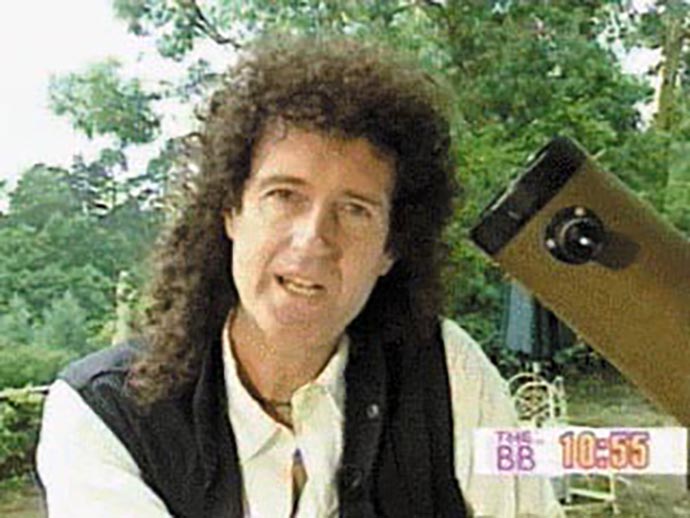
GET TOTALLY ECLIPSED WITH BRIAN MAY
BIGGER ECLIPSE BREAKFAST
Channel 4 TV (UK)
11 Aug 1999 (approx 11.00 hrs)
PART ONE
BRIAN MAY speaking (and demonstrating) from his Surrey home (pre-recorded)
Brian May – The Bigger Breakfast. Brian spoke to Richard Bacon from Glastonbury Tor:
Hi Folks.
I’m Brian May. I’m probably better known to you as a musician but today I’m gonna be talking to you about Astronomy. I’m standing beside this little telescope which my dad and I made – er – probably about the time we were starting thinking about making a guitar, so my passion for Astronomy has kind of gone hand in hand with the passion for music over years… … Bri
—
RICHARD BACON from Glastonbury Tor:
But now to hear about the hard astronomical facts from keen amateur astronomer and lead guitarist with Queen, Brian May.
Music: One Sun One Vision, Just Give Me One Sun Vision
CAPTION: GET TOTALLY ECLIPSED WITH BRIAN MAY
BRIAN MAY:
Hi Folks. I’m Brian May. I’m probably better known to you as a musician, but today I’m gonna be talking to you about Astronomy. I’m standing beside this little telescope which my dad and I made – er – probably about the time we were starting thinking about making a guitar, so my passion for Astronomy has kind of gone hand in hand with the passion for music over years.
So today I’m gonna be talking to you about eclipses and how they come about and roughly what you can expect to see.
Music: “Gimme, gimme, gimme Sun vision.”
An eclipse of the Sun happens when the Moon gets in the way of light coming from the Sun towards the Earth and in this position exactly you can see that the Moon is gonna cast a shadow on the earth. If you’re lucky to be in this spot, you’ll see a total eclipse.
By an amazing coincidence – or is it? – the Sun and the Moon appear to be almost the same size in the sky, as viewed from the Earth. But in reality the Moon (I have a Macadamia Nut for the Moon here now) the Moon is 400 times smaller than the Sun, but it’s also 400 times nearer to us, and so you can see, due to the effects of perspective, my Macadamia Nut will just exactly cover the sun – and there we have our total eclipse.
Here we have a little model of the Earth/Moon system. A little toy orrery. Er – here’s the Sun, the Earth and the Moon – and you can see that as the Earth gradually makes its way around the Sun, the Moon is going around the Earth and every month it’ll come roughly between us and the Sun.
So why don’t you get a total eclipse every month? The reason is the plane of the Moon’s orbit is not exactly the same plane as our orbit around the Sun, er, and normally the Moon will either go or just below or just above the Sun. It’s only certain times when it’s come exactly the right place to cause a total eclipse.
Music: “Gimme, gimme gimme Sun Vision”
RICHARD:
Thank you Brian for giving us the astronomical insight there.
PART TWO
JOSIE D’ARBY from The Lizard Festival:
On today’s show we’re gonna tall you exactly what you can expect from the eclipse and exactly what to look out for and in fact we’ll do that right now with our astronomical rock star, Brian May.
Music: “One Sun, one vision
Just give me one Sun vision”
BRIAN:
Hi, I’m Brian May and I’m gonna run through now exactly what you can expect to see in the total eclipse which is happening in the next few hours over Great Britain.
Music: “Gimme, gimme, gimme Sun vision.”
This is the path of the Moon’s shadow as it travels over the Earth. If you live anywhere on this line you’ll experience the full effect of the eclipse. It’ll be pretty dark for a couple of minutes.
(Dramatic orchestral music begins)
This is called “the path of totality”.
There are four crucial moments to this eclipse. First Contact is the point where the Moon just is starting to nibble a little piece out of the Sun. Second Contact is the point where the Moon exactly covers the Sun’s surface. That’s the beginning of the totality.
So now we come to some very dramatic moments. The final little sliver of the sun will appear to break up into many tiny little pieces and it looks like a string of beads, or some beads on a wire. This is called ‘Baily’s Beads’. These beads will disappear and we’re into this AMAZING time when blackness is upon us – well almost blackness. You’ll be able to see a few stars coming out quite clearly now and the most amazing thing to see I think for everyone is the corona of the Sun’s atmosphere which surrounds the blackened out Sun.
The next phenomenon is the diamond ring where you’ll see the Sun just glinting through perhaps one lunar valley and it looks a lot like a diamond ring. This is the, the danger sign. Whatever you want to do at this point, just don’t look at the Sun, okay, because we’re now at Third Contact which is the point at which the Moon is JUST starting to move away and you start to see a little sliver of Sun again, and Fourth Contact is the point where its just about all over the the Moon is just moving off the edge of the Sun.
There, that’s all from me. Folks – remember safety throughout the eclipse, but I hope you have clear skies and enjoy the last eclipse of this Millennium.
(Dramatic Music comes to a close)
RICHARD:
Thank you once again Brian for your facts, and welcome back live to Glastonbury Tor.
(Transcribed by J Tunney)